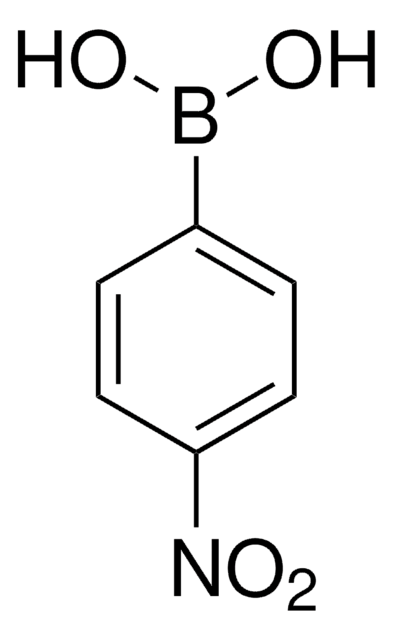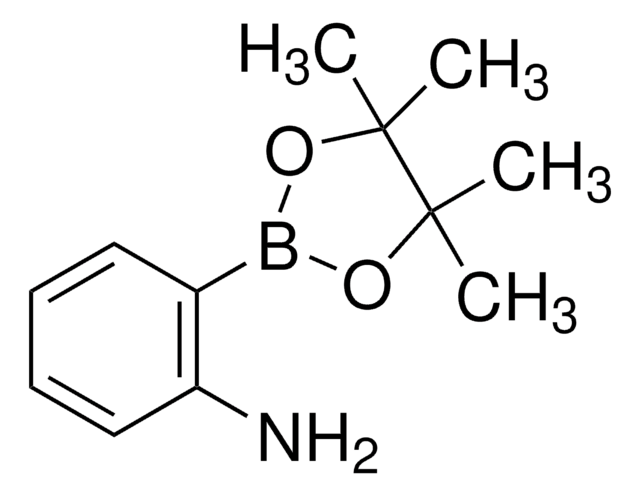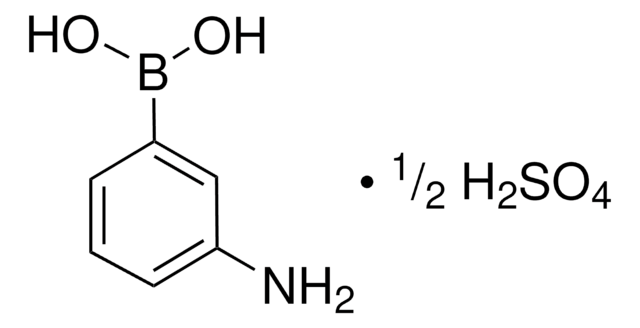708887
4-Aminophenylboronic acid hydrochloride
95%
Synonym(s):
4-Aminobenzeneboronic acid hydrochloride
Sign Into View Organizational & Contract Pricing
All Photos(2)
About This Item
Linear Formula:
C6H8BNO2 · HCl
CAS Number:
Molecular Weight:
173.41
MDL number:
UNSPSC Code:
12352103
PubChem Substance ID:
NACRES:
NA.22
Recommended Products
Assay
95%
form
powder
mp
195-200 °C
SMILES string
Cl.Nc1ccc(cc1)B(O)O
InChI
1S/C6H8BNO2.ClH/c8-6-3-1-5(2-4-6)7(9)10;/h1-4,9-10H,8H2;1H
InChI key
QBYGJJSFMOVYOA-UHFFFAOYSA-N
Looking for similar products? Visit Product Comparison Guide
General description
May contain varying amounts of anhydride
Application
4-Aminophenylboronic acid hydrochloride can be used to prepare:
- The modified reduced graphene composite material used as a sugar sensor to detect the analyte in fruit juice.
- The modified carbon electrode adsorbed with aminophenol, used for the detection of NADH and H2O2.
- The boron, nitrogen, and sulfur-doped carbon dot sensor, which in turn can be used for the detection of ascorbic acid.
Reactant for:
- Preparation of chromen-4-ones as DNA-dependent protein kinase inhibitors
Signal Word
Warning
Hazard Statements
Hazard Classifications
Acute Tox. 4 Oral
Storage Class Code
11 - Combustible Solids
WGK
WGK 1
Flash Point(F)
Not applicable
Flash Point(C)
Not applicable
Personal Protective Equipment
dust mask type N95 (US), Eyeshields, Gloves
Choose from one of the most recent versions:
Already Own This Product?
Find documentation for the products that you have recently purchased in the Document Library.
Customers Also Viewed
Qi Wang et al.
Biosensors & bioelectronics, 50, 331-337 (2013-07-25)
A sensitive electrochemical active interface for sugar sensing based on the specific boronic acid-diol binding was established. The sensing matrix was formed by stirring a suspension of graphene oxide (GO) with 4-aminophenylboronic acid (APBA). The resulting composite consists of a
Sabrina Belbekhouche et al.
Colloids and surfaces. B, Biointerfaces, 177, 416-424 (2019-02-25)
Glucose-responsive multilayer capsules have been produced through the layer-by-layer deposition of biodegradable polymers based on hydrogen bonding. The used polymers are alginate derivative and polyvinylpyrolidone (PVPON). Concentration-dependent glucose responsiveness was reached through chemical modification of alginate, selected as polyanion, with
A dual-mode sensor for colorimetric and ?turn-on? fluorescent detection of ascorbic acid
Liu Y, et al.
Dyes and Pigments, 149, 491-497 (2018)
Bo Peng et al.
Analytical and bioanalytical chemistry, 412(4), 861-870 (2019-12-23)
In this paper, we report the use of a smartphone and B, N, and S co-doped carbon dots (BNS-CDs) as a promising peroxidase mimic to quantify hydrogen peroxide (H2O2). The synthesized BNS-CDs exhibited excellent peroxidase-like activity to catalyze the reaction
Sun Dal Kim et al.
Science advances, 4(10), eaau1956-eaau1956 (2018-11-07)
The key component currently missing for the next generation of transparent and flexible displays is a high-performance polymer material that is flexible, while showing optical and thermal properties of glass. It must be transparent to visible light and show a
Our team of scientists has experience in all areas of research including Life Science, Material Science, Chemical Synthesis, Chromatography, Analytical and many others.
Contact Technical Service













